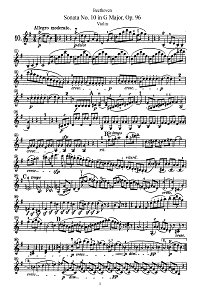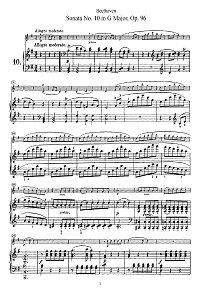Beethoven - Violin sonata N.10 G-dur
Beethoven - Violin sonata N.10 G-dur. You can download the PDF sheet music Beethoven - Violin sonata N.10 G-dur on this page. Violin Sonata No. 10 in G major ■ sol majeur • G-Dur, op.96
- Allegro moderato
- Adagio espressivo
- Scherzo: Allegro
- Poco allegretto
The G major sonata opus 96 was first performed in Vienna on 29 December 1812. Beethoven probably began it in February (first movement), and wrote the middle movement in November, shortly after the completion of the eighth symphony, but he did not compose the finale until after the arrival in Vienna early in December of the famous violinist Pierre Rode, who gave the work its first performance. That was at a private concert at Prince Lobkowitz's mansion, with the dedicatee, Archduke Rudolph, as the pianist. The Archduke must have been an uncommonly good player if his performance was up to Rode's standard — though Spohr mentions that the great
virtuoso had lost some of his skill by 1812. It is surprising that this magnificent and large-scale sonata — Beethoven here returns to the four-movement layout of opus 24 and opus 30 no.2 - was not published until July 1816, when it was brought out by Steiner of Vienna.
To download PDF, click the "Download PDF" button below the appropriate sheet music image.
To view the first page of Beethoven - Violin sonata N.10 G-dur click the music sheet image.
|
| PDF format sheet music |
|
|
|
Instrument part: 7 pages. 1062 K
|
Piano part: 25 pages. 3109 K
|
 |
 |
|
|
| Download PDF (14.99
€) |
Download PDF (14.99
€) |
|
The principal themes of the opening Allegro moderato are rather brief and quite straightforward, but they are developed with all the skill of Beethoven's full maturity. In place of the sometimes unbalanced dialogue of some of the earlier sonatas we find here a resilient unity that, underlying contrasting moods and phrases, is the inevitable product of the uncompromising, thematic material. At the opening of the Adagio espressivo the piano gives'out a long, meditative melody in E fiat, accompanied only towards its end by the violin - though it is the violin that then takes over this almost vocal line. The calm, reflective mood of the movement prevails until, just as the melody seems about to die away into silence, the Scherzo (Allegro) is attacked without a break. The restless momentum of the G minor scherzo is halted only by the joyful trio, which returns to the key of the slow movement. The repeat of the scherzo is rounded off by a brief major key coda. The finale, marked Poco allegretto, is a freely developed rondo which has as its theme a simple folksong-like fragment. Exposition of the theme is followed by a set of variations, and that in turn by a poignant return to the tempo of the slow movement. The theme is heard again, then after the tempo has increased to allegro, we have a short fugal passage.
|
|